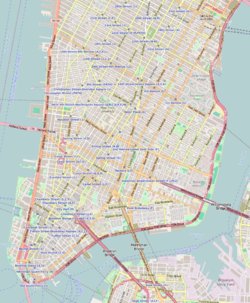Former New York Life Insurance Company Building
|
Former New York Life Insurance
Company Building |
|

the building after Hatch's and McKim, Mead & White's extension and redesign
|
|
| Location | 346 Broadway, New York, New York |
|---|---|
| Coordinates | 40°42′58″N 74°0′13″W / 40.71611°N 74.00361°WCoordinates: 40°42′58″N 74°0′13″W / 40.71611°N 74.00361°W |
| Built | 1894 |
| Architect | Stephen D. Hatch; McKim, Mead & White |
| Architectural style | Late 19th And 20th Century Revivals |
| NRHP Reference # | |
| Significant dates | |
| Added to NRHP | June 28, 1982 |
| Designated NYCL | February 10, 1987 |
The Former New York Life Insurance Company Building, also known as the Clock Tower Building, was built as an office building located at 346 Broadway (with a secondary address of 108 Leonard Street) between Catherine Lane and Leonard Street, in Manhattan, New York City. Constructed in two stages, from 1868 to 1870 and from 1894 to 1899, it is a New York City Landmark and is listed on the U.S. National Register of Historic Places.
The New York Life Insurance Company's headquarters building was originally built in 1868-1870. It needed to be expanded eastward to Lafayette Street and Stephen Decatur Hatch was engaged for the job. Hatch designed the extension, but died before construction could be completed. The firm of McKim, Mead & White took over the work, and completed the extension in 1894, following Hatch's design. The company then decided to replace the original building as well, and McKim, Mead & White provided an Italian Renaissance Revival style "palazzo-like" design with a clock tower whose clock was manufactured and installed by the E. Howard Clock Company.
The building's prominent clocktower was topped with 33-foot tall, eight ton, sculpture made by Philip Martiny, who studied under Augustus Saint-Gaudens. The piece consisted of four, 11-foot tall, crouching figures of Atlas, on whose shoulders rested a 15-foot diameter hollow globe, which was topped off with a 7-foot-tall eagle. The gigantic statue was removed in the late 1940s and has been lost ever since.
New York Life left for the New York Life Building on Madison Square Park in 1928. In 1967, the City of New York acquired the building and moved several city agencies along with the Criminal Court, Summons Part there. The building was added to the National Register of Historic Places in 1982, and the exterior, interior and historic E. Howard Company clock were all designated New York City landmarks in 1987 by the New York City Landmarks Preservation Commission. The building is also included in the AIA Guide to New York City. In January, 2013 the City of New York sold the building to developers Elad Group and the Peebles Corporation for $160 million.
...
Wikipedia



